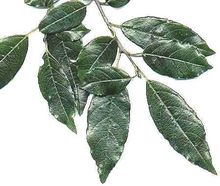African buckthorn
| African buckthorn | ||||||||||||
|---|---|---|---|---|---|---|---|---|---|---|---|---|

African buckthorn ( Rhamnus prinoides ), branch with fruits |
||||||||||||
| Systematics | ||||||||||||
|
||||||||||||
| Scientific name | ||||||||||||
| Rhamnus prinoides | ||||||||||||
| L'Hér. |
The African buckthorn ( Rhamnus prinoides L'Hér. , Syn. : Rhamnus pauciflora . A.Rich ) in Ethiopia Gesho called, is a plant type , which the family of the Buckthorn family belongs (Rhamnaceae).
description
The African buckthorn is an evergreen shrub or small tree that can reach heights of up to 9 meters, at higher altitudes it reaches heights of 4 to 5 meters. The bark is smooth, grayish-brown and turns dark brown with age, on young twigs it is downy hairy, later glabrous. The leaves are arranged alternately on the branches. The simple leaf blade is elongated-elliptical with a length of 1.5 to 5 centimeters and a width of 2.5 to 10 centimeters. The leaf tips are curved downwards. The upper side of the leaf is glossy dark green and the underside of the leaf is matt.
Up to ten short-stalked flowers stand together in clusters in the leaf axils. The small, inconspicuous flowers are five-fold. The petals are greenish. The pea-large (5 millimeters), berry-like, and bright red, sometimes black when fully ripe drupes contain three seeds and are edible. In southern Africa the flowering time is between October and December, fruits form in spring.
Occurrence
The African buckthorn occurs at medium altitudes in eastern Africa. Its original range is South Africa and the highlands of Ethiopia , where it thrives at altitudes of up to 2100 meters. Its distribution area includes Ethiopia, Kenya, Uganda, Tanzania, Angola, Malawi, Mozambique, Zambia, Zimbabwe, Cameroon, the Democratic Republic of the Congo and southern Africa. It is particularly found near rivers or the edges of forests. In front of the light, grassy hills of the South African highlands, the small trees standing together in groups appear almost black because of their dark leaves. The African buckthorn can endure frost well, grows in the sun and also in partial shade.
use
The use of the African buckthorn is very different in the two areas of distribution. The main use in South Africa and Lesotho lies in the traditional use of the branches as a spell for defense against lightning and in general against anything sinister. The Basotho people call the tree Mofifi , and their habitat in the Lesotho highlands has one of the highest numbers of lightning strikes per square kilometer. At the same time, fruits and leaves are used in herbal medicine against various diseases. The name Blinkblaar in Afrikaans carries both this type of buckthorn and the buffalo thorn ( Ziziphus mucronata ), which is said to have a similar effect.
In Ethiopia, the leaves and wooden stems are used to make tej (honey wine) and tella (millet beer) as an additive during fermentation . The bitter-tasting leaves are dried and ground and then added to the tella; for Tej, dried Gesho stems are boiled in water, then the brew is added to the honey. The use of an alcoholic drink is already mentioned by the Greek geographer Strabo (63 BC to 23 AD). Ethiopian society, which has been strictly hierarchical since time immemorial, assigned the higher-quality Tej, in which different quality levels were differentiated, a corresponding cultural meaning and only allowed the lower folk to enjoy the simple Tella. On certain occasions the ruler served these drinks to the people according to the social order and to strengthen it. The Gesho tree is therefore of cultural importance in Ethiopia.
The wood is yellowish-white, interspersed with dark veins, moderately hard and, to a lesser extent, suitable as joiner's wood . It makes more sense to use it to control erosion at the edge of streams and as wind protection at field edges. The flowers are popular with bees.
literature
- Mhlonishwa D. Dlamini, Sharon Turner: Rhamnus prinoides L'Hérit. Witwatersrand National Botanical Garden, March 2002. at plantzafrica.com .
- Rhamnus prinoides. ( Memento from April 16, 2013 in the web archive archive.today ) at AgroForestryTree Database. A tree species reference and selection guide . ( Memento from April 16, 2013 in the web archive archive.today )
Individual evidence
- ^ Rhamnus in the Germplasm Resources Information Network (GRIN), USDA , ARS , National Genetic Resources Program. National Germplasm Resources Laboratory, Beltsville, Maryland. Retrieved February 19, 2018.
- ^ Mhlonishwa D. Dlamini, Sharon Turner: Rhamnus prinoides L'Hérit. Witwatersrand National Botanical Garden, March 2002.
